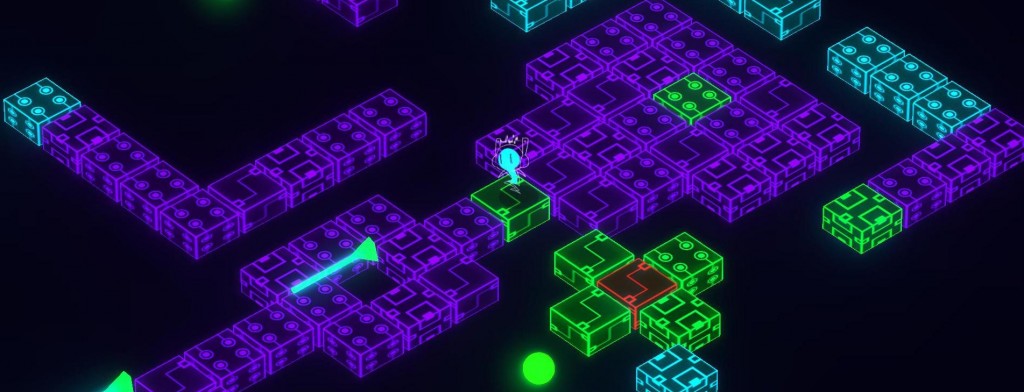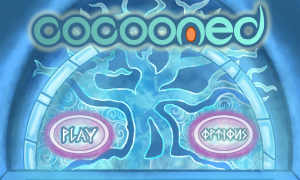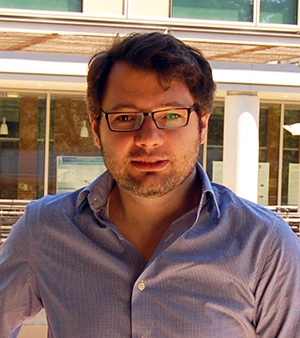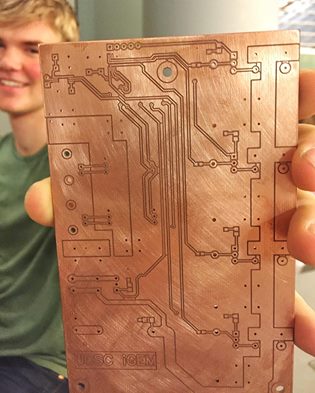Santa Cruz Tech Ecosystem
UCSC Games and Playable Media Programs take it to the Next Level
by Grace Lukach
Exploring the three different degree options: undergraduate, masters, and doctorate.
The First Level
With electronic music bumping in the background, you jump along an isometric path toward the next level. You are bulbous and blue, and are trying to avoid the deadly obstacles that pulse and pivot with the music. Can you make it to the red tile at the end?
This rhythmic new game, DJ Gone Rogue, is being developed by a group of ten students as a senior capstone project for the undergraduate degree in Computer Game Design at UC Santa Cruz. They designed every element of the game: developing the idea, programing the game code, creating the art, and producing the music—a different song for each level. It will ship at the end of June and be available for mobile play.
Programmer and audio coordinator on the DJ Gone Rogue team, Davidson Harley, reflects on his four years in the UCSC program: “You get to focus on projects you want to complete, not so much just taking tests and having the right answers. You get to create your own problems and figure them out.” This year there are fourteen groups of students, each producing their own game.
The undergraduate program offered through the UC Santa Cruz Center for Games and Playable Media is on the Princeton Review’s list of the top 25 undergraduate schools to study game design for 2014.
“We have a pretty unique approach to thinking about games here, it’s different than most other programs,” says Professor Michael Mateas, “it’s this idea of really, in a sense, moving beyond games to other kinds of playable experiences.” He sees the program prepare students for a wide range of jobs in the tech industry. “We’re not narrowly preparing people so all they know how to do is go into games. It’s more that you know how to design rich interactive experiences—games are an example of that. You know how to design them and implement them,” Mateas says.
The faculty and their research are essential to the unique approach to teaching game design at UCSC.“We have all these leaders in computer game research,” says Jim Whitehead, Professor and Chair of Computer Science. This cutting-edge faculty pushes students to be more innovative. Students emerge from the program inventive and with high technical competence.
Before introducing the Computer Game Design degree in 2006, the faculty noticed an increasing interest in game design. Whitehead estimates that a third to a half of incoming computer science students were coming to study game design, but there were few courses dedicated to the subject. Almost a decade later, there are about 100 students pursuing the computer game design degree every year and around 250 students studying general computer science.
Advanced Players
In addition to the undergraduate degree, the Center for Games and Playable Media offers various graduate degrees. UCSC ranked 7th on the Princeton Review’s list of the Top 25 Graduate Schools to Study Game Design for 2014. Students can choose to pursue a professional M.S. in Games and Playable Media, a Ph.D. or M.S. in Computer Science with a focus on games, or a M.F.A. in Digital Arts and New Media.
The new professional masters degree is a one-year intensive program run by acclaimed game designers Brenda and John Romero. It is a small and selective program and prepares students to be leaders in the gaming industry. Code and design are at the core of the program, and graduates are equally adept to work in small indie settings or corporate game design companies. Located in Silicon Valley in a brand new studio, students are surrounded by a variety of game companies. Brenda Romero, who was named one of the Top 10 Game Developers of 2013, describes her students as “the up and coming rock stars in the industry.”
Students in the professional masters degree are not only taught by leaders in industry and game research, but also receive the guidance of an exceptional advisory board. Made up of successful game designers, the advisory board helps students with projects and gives them industry insight. “I’m thrilled with the level of commitment of our advisory board,” says Brenda Romero.
Back at the main UCSC campus, graduate students in computer science with a focus on games work with faculty members on computer game research. They graduate prepared for long-term research and careers in academia. Professor Mateas and his students focus their study on the dynamic process of interactive storytelling.“What happens if we have dynamic and rich simulations of emotions, and you can dynamically play an emotional system or you can dynamically play a relationship?” he asks. With the help of his students, who earn dissertations exploring these questions, Mateas is ambitious: “I want us to develop computational models and playable simulations of every aspect of human experience.”
Finally, the M.F.A. in Digital Arts and New Media is a two-year interdisciplinary program. Faculty and students come together with different experiences and education to broadly explore digital media and culture. Part of the program includes work on collaborative research projects and playable media is one possible area of research.
Shipping Soon
Colorful tape and sticky notes cover the walls of the UCSC game lab. Another group of undergraduates admire a panel their artist recently completed for their game, Cocooned. The game is the adventure story of Kipcha, who leaves her tribe and travels through different worlds collecting runes and solving puzzles. “Everything is hand-drawn in the game, so there are going to be 15 levels with 42 panes in each level, and then there’s 20 or so cut scenes,” says artist Brittney Sager. “It’s a lot of work but it’s definitely really rewarding and it’s definitely about time management.” She wants to be a video game artist, but is pursuing a general art major because there is no digital focus for undergraduates studying art. She does all the work for the Cocooned team in addition to other major requirements for the art program.
Sager is not alone in seeking an artistically focused undergraduate game design degree. Realizing this need, the faculty is planning to introduce a B.A. in Computer Game Design through the arts division in addition to the B.S. in the computer science department. The two programs will have similar introductory courses, but as the B.S. moves more deeply into the technical elements of game design, the B.A. will explore artistic design. “That’ll be a very compelling package for people and I think that’s also what it will take to lift us up to the very top levels of those Princeton Reviews as well,” says Whitehead.
In the meantime, the fourteen groups of undergraduates spend late nights in the game lab working to finish their games. They will present their completed games to a packed Rio Theater at the annual Sammy Awards in June. Stay tuned for Santa Cruz Tech Beat’s coverage of the event!
###
Grace Lukach is a biology student at UC Santa Cruz.
###
Sara Isenberg publishes Santa Cruz Tech Beat for the benefit of the extended business and technology community. When she is not volunteering her time for the tech scene, Sara makes her living by managing software projects, web strategy planning, and providing development team services (including account management, vendor management, strategic partner management, beta project management, referrals to qualified technical team members, and more). Please visit her website: Sara Isenberg Web Consulting & Project Management, or contact Sara by email if you have any project management, account management, or Development Team leadership or service needs.
Tagged Games and Playable Media, UC Santa Cruz, UCSC Center for Games and Playable Media










